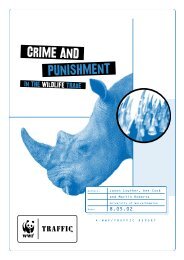In full swing: assessment of trade in orang-utans and ... - WWF UK
In full swing: assessment of trade in orang-utans and ... - WWF UK
In full swing: assessment of trade in orang-utans and ... - WWF UK
Create successful ePaper yourself
Turn your PDF publications into a flip-book with our unique Google optimized e-Paper software.
gibbons <strong>and</strong> <strong>orang</strong>-<strong>utans</strong> <strong>in</strong> zoos. Geissmann (2003) reported similar f<strong>in</strong>d<strong>in</strong>gs when he made an <strong>in</strong>ventory <strong>of</strong> the<br />
captive gibbon population <strong>in</strong> <strong>In</strong>doch<strong>in</strong>a: a large proportion <strong>of</strong> the gibbons <strong>in</strong> Ch<strong>in</strong>a, Vietnam <strong>and</strong> Laos comprised<br />
immature <strong>in</strong>dividuals (some 60% <strong>of</strong> the total), whereas <strong>in</strong> Western zoos, immature <strong>in</strong>dividuals made up only about 30%<br />
<strong>of</strong> the sample.<br />
When the orig<strong>in</strong> <strong>of</strong> the animals <strong>in</strong> the Javan <strong>and</strong> Bal<strong>in</strong>ese zoos was known, the majority were either said to have been<br />
received from the BKSDA or, alternatively, from private owners. It was <strong>in</strong>terest<strong>in</strong>g that some zoos (e.g., Kebun B<strong>in</strong>atang<br />
B<strong>and</strong>ung) claimed to have received the vast majority <strong>of</strong> gibbons from private owners who wanted to dispose <strong>of</strong> their pet<br />
gibbon (although, yet aga<strong>in</strong>, more than 60% <strong>of</strong> all gibbons <strong>in</strong> this zoo were not yet adult) <strong>and</strong> none was the result <strong>of</strong> confiscations.<br />
Other zoos (e.g., Kebun B<strong>in</strong>atang Surabaya) claimed exactly the opposite, with almost all be<strong>in</strong>g the result <strong>of</strong><br />
confiscations made by the BKSDA, <strong>and</strong> none be<strong>in</strong>g received as donations.<br />
Table 9.<br />
Gibbons <strong>and</strong> <strong>orang</strong>-<strong>utans</strong> <strong>in</strong> Javan <strong>and</strong> Bal<strong>in</strong>ese zoological gardens, <strong>and</strong> their reported orig<strong>in</strong>. Zoos are: Pusat<br />
Primata Schmutzer, Jakarta; Ragunan, Jakarta; Taman Safari Cisarua; Kebun B<strong>in</strong>atang B<strong>and</strong>ung; Gembiraloka,<br />
Yogyakarta; Taru Jurug Surakarta; Kebun B<strong>in</strong>atang T<strong>in</strong>jomoyo, Semarang; <strong>and</strong> Taman Kaloko Widya M<strong>and</strong>hala,<br />
Purwokerto; Kebun B<strong>in</strong>atang Surabaya;Taman Safari Pasaruan; <strong>and</strong> Bali Zoo Park.<br />
Confiscated Donation Captive-bred Transfer* Unknown Total<br />
H. moloch 3 24 2 15 11 55<br />
H. agilis 15 2 1 2 16 36<br />
H. albibarbis 1 6 2 9 5 23<br />
H. muelleri 0 0 0 2 17 19<br />
H. klossi 1 0 0 0 0 1<br />
S. syndactylus 9 11 4 2 29 55<br />
P. pygmaeus 10 5 4 17 71 107<br />
P. abelii 2 0 1 5 4 12<br />
Total (%) 41 (13) 48 (16) 14 (5) 52 (17) 153 (50) 308<br />
* Transfer refers to animals that were bartered from other zoos or animals that have been received from other zoos.<br />
Data source: This survey (2003) <strong>and</strong> Yuda, 2003<br />
Comparison between bird markets, wildlife rescue centres <strong>and</strong> zoological gardens<br />
Table 10 presents a summary <strong>of</strong> the total number <strong>of</strong> gibbons <strong>and</strong> <strong>orang</strong>-<strong>utans</strong> <strong>in</strong>cluded <strong>in</strong> the <strong>assessment</strong>. <strong>In</strong> all, data was<br />
collected on 559 <strong>in</strong>dividuals <strong>of</strong> seven species <strong>of</strong> gibbon <strong>and</strong> both species <strong>of</strong> <strong>orang</strong>-utan. Strik<strong>in</strong>g are the large<br />
number <strong>of</strong> Bornean Orang-<strong>utans</strong>, Siamangs <strong>and</strong> Javan Gibbons, whereas the number <strong>of</strong> White-h<strong>and</strong>ed <strong>and</strong> Kloss'<br />
Gibbon, as well as the Sumatran Orang-utan are particularly small. The difference between the large number <strong>of</strong><br />
Siamangs encountered at bird markets, zoos <strong>and</strong> <strong>in</strong> private h<strong>and</strong>s, <strong>and</strong> the relatively smaller number <strong>of</strong> the other species<br />
<strong>of</strong> gibbon may be related not just to the number <strong>of</strong> <strong>in</strong>dividuals captured but also to the differences <strong>in</strong> survival chances<br />
between the two. As <strong>in</strong>dicated <strong>in</strong> the <strong>in</strong>troduction, the Siamang is more <strong>of</strong> a folivorous species than the Hylobates<br />
gibbons, <strong>and</strong> their choice <strong>of</strong> diet is more flexible.<br />
IN FULL SWING:ASSESSMENT OF TRADE IN ORANGUTANS AND GIBBONS ON JAVA AND BALI,INDONESIA 31


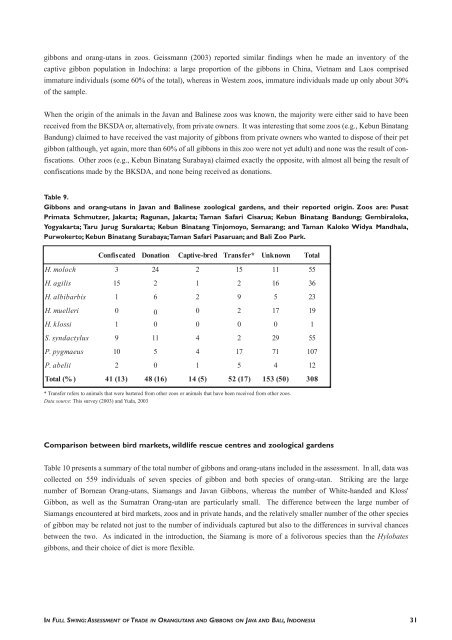
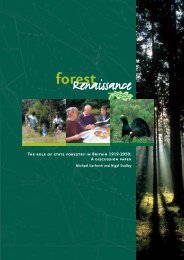
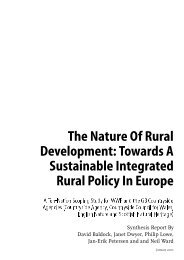
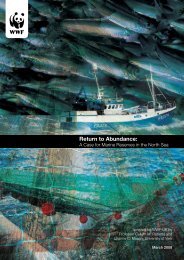

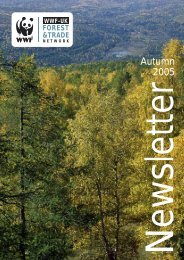

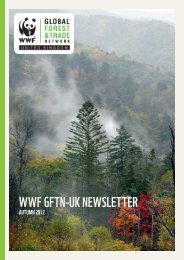
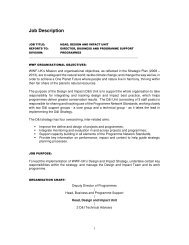
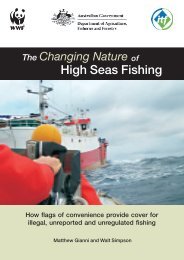
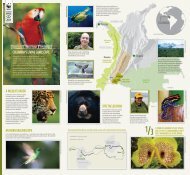
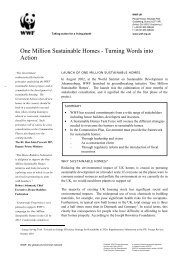
![[PDF] Causes for concern: chemicals and wildlife - WWF UK](https://img.yumpu.com/31929970/1/184x260/pdf-causes-for-concern-chemicals-and-wildlife-wwf-uk.jpg?quality=85)
